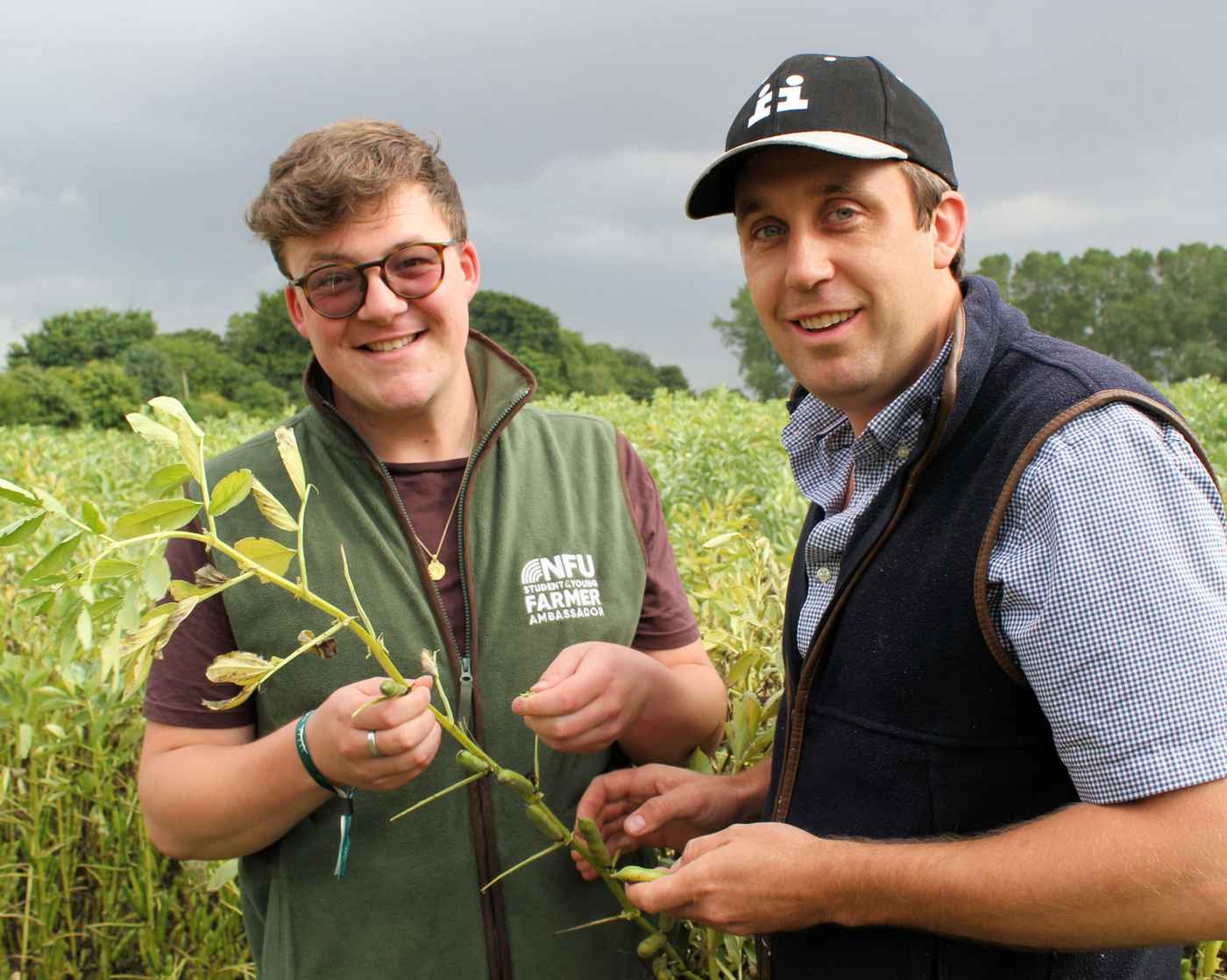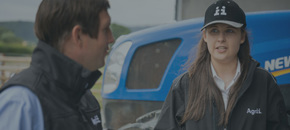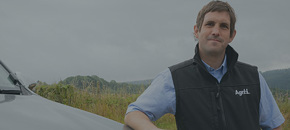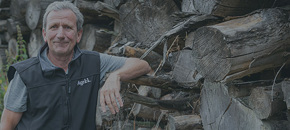
Fully-integrated Wiltshire approach to sustainable farming | Green Horizons Blog
Blog - 04.10.22
Growing from a single 150 acre farm to 1400 owned hectares in 12 units across north Wiltshire and south Gloucestershire over the past seven years, Malmesbury-based
CP Farming is taking a fully-integrated, three-pronged approach to sustainability.
Under the guidance of innovative young manager and NFU Student and Young Farmer Ambassador, Mike Wilkins, the current 900ha of arable cropping, 200ha of Stewardship and 300ha of permanent pasture, woodland and miscanthus are run in a way that supports people, profitability and nature.
The business model: equal profit share-farming
Under a family owner passionate about social as well as economic and environmental sustainability, all the arable cropping is managed under equal profit share-farming agreements with local farming businesses. This allows it to make far more of an employment contribution than would be the case with either in-hand or single contractor management.

Mike Wilkins (left) and Ollie Pattemore checking one of their promising bean crops.
Alongside these agreements, Mike and his core team run a flock of 1000 ewes managed by head shepherd Jess King, together with the entire Stewardship area ‘in house’ as separate enterprises. At the same time, he and Agrii agronomist, Ollie Pattemore, work closely with their cropping partners to ensure the Green Horizons network business is developed and managed to mutual benefit.
“We plan what we’re going to do together to both meet the core trajectory we have across our business and make the most of their farming expertise and resources,” explains Mike. “We provide all the inputs and agronomy, while our partners supply the machinery and labour. Splitting the profits 50/50 ensures we are all working to the same goal.
“Our sheep travel widely from Tetbury to Marlborough utilising the Stewardship options and cover crops in the arable rotations as well as our permanent grassland. We contract all the fieldwork involved in the establishment and maintenance of these areas to our farming partners separately.”
CP Farming's sustainability roadmap
Growing crops for human use, minimising cultivation, reducing inputs, improving soils and encouraging both wildlife and responsible public access are all key elements of CP Farming’s direction of sustainability improvement travel. But the very last thing it wants to be is too prescriptive over the way they are achieved.
When the business acquires new land, the first thing it does is work with whoever is farming it (or a local partner if the existing farmer is retiring) to understand the ground and the current system and resources. All the fields are conductivity scanned as part of the Rhiza digital package to establish a baseline for their future management. And the most appropriate Stewardship areas and options are planned, agreed and entered into.
“Our land ranges from chalk with flint to Cotswold brash, heavy clay over chalk and everything in between,” says Mike. “Add to this the fact that our partners invariably know it better than we do and have different machinery fleets as well as approaches, and we are always open-minded about the management specifics as long as they meet the general direction we want to go in.
“Reducing tillage is an important part of this, for instance. But Ollie and I would never tell anyone not to plough or insist on zero tillage. Instead, we work with them to explore ways of cutting back on cultivations appropriate for their conditions and needs.”
Learning from experience
“We know how well this approach works from the other side, as Mike’s family were actually one of the business’ first partners on a block of land they were contract farming when it was acquired,” points out Ollie.
“On the heavy clay there and their own Nolands Farm near Calne they had always favoured a fairly intensive cultivation regime. “Working with them, we have found strip till Mzuri drilling the ideal answer for both parties. It still does the cultivation the ground needs but confines this to the seeding strip. As well as improving soil structure, this has cut down seedbed preparation time and, with it, weather risk – not to mention cost – massively. Strip tilling has since become the establishment regime of choice at Nolands too.”
Targeted nutrition for soil improvement
Alongside the carefully targeted – as much as reduced – tillage now being practised in different forms across CP Farming’s cropped area, sewage sludge has been introduced into all the rotations over the past three years as part of the soil improvement efforts.
Supplied in a full package from Wessex Water, it is generally applied after winter barley and before the oilseed rape that remains the principal cereal break despite continuing issues with cabbage stem flea beetle. In some rotations it also goes on before the winter wheat the business aims to grow as much of as possible.
“The sludge is very useful on our generally low P indexing land,” Ollie says. “The readily available phosphate it provides – and any flea beetle repellent effect – makes it particularly valuable ahead of the OSR. Having said that, the spreading logistics can be a problem where we want to get the crop in early as part of our CSFB defence.
“Where sludge isn’t applied in the autumn and ahead of most spring crops we now employ specialist starter fertilisers as standard practice, taking advantage of the flexibility all our partners’ drills now have to put them down the spout.
“Placing early nutrition where’s it’s most needed means we use less P & K, in particular, these days. And by getting our crops off to the best possible start, tissue testing at key stages of crop growth and tailoring micro-nutrition carefully to crop need through the season using the Agrii/Lancrop graphs, we are able to maximise nutrient use efficiency.”
Reducing inputs and diversifying rotations
In addition to better targeting fertilisers and other inputs within the crops they grow, the
CP Farming team’s input-reduction focus is very much on ‘the bigger picture’. Including more lower input crops like spring and winter beans, spring linseed and canary seed in their cropping is proving a good way of reining back on total farm inputs as well as extending and diversifying the rotations.
Miscanthus growing as a trial on 20ha of particularly poor ground is also showing its value here, with Mike keen to grow more energy crops in the future and use them in the biomass boilers already installed in seven of their properties.
Around 66ha of GS4 Stewardship herbal leys (soon to increase) in the arable rotation are playing their part in reducing inputs too, while adding to the soil improvement efforts and providing a better nutritional entry for the wheat crops.
Also valuable in reducing overall input use are the 4-6 m margins down to AB1 and AB8 pollen and nectar mixes around all fields and AB9 winter bird food blocks grown on the least productive arable land.
“The income it provides helps, but Stewardship is an important element of our recipe in so many other ways,” Mike stresses. “In particular, concentrating our cropping on the most productive ground allows us to focus our inputs as cost-effectively as we can, leaving land with the least cropping potential for wildlife instead where it will deliver the greatest habitat value.
“All our Stewardship is based on Wildlife Offers and completely bound-up with our sheep. The herbal leys provide excellent ewe and lamb feed while they, in turn, manage the leys as they need to be.
“AB13 brassica fodder crops are equally valuable for lamb fattening, as are the other cover mixes we grow ahead of our linseed and canary seed. Being later sown, these give far more leeway for sheep grazing than covers before spring barley.
The integrated approach
“Bred for ease of management, worm resistance and production from grazing, the bulk of our sheep are Exlanas,” he explains. These are perfect for our all-outdoor system. The fact that they don’t need shearing is another big advantage. And it’s amazing how rapidly the shed fleeces are cleaned-up by birds and incorporated into the ground by worms, giving extra environmental benefits.
“Alongside them, we have just invested in a flock of Romneys for their premium wool which we intend to supply to the environmentally-conscious fashion and furniture markets that our owners are also involved in. This is a perfect fit with our focus on growing crops for human use rather than animal feeding wherever possible.”
What does the future hold?
So what of the future then? How do Mike and Ollie see the business developing further along the road to greater all-round sustainability?
Well, they are keen to extend CP Farming’s Stewardship agreements and push up the area involved significantly as their original five-year terms come to an end. Knowing they will be able to move into the Local Nature Recovery element of ELMs at any stage, they are waiting until its substance becomes clear before considering any switch.
They are also looking to build on the 12m or so of wildlife corridors they already have in the 4-6m margins either side of each field boundary, adding avenues of trees to enhance the value of these networks across the business’ farms.
A move into silvopasture – putting more trees parkland-style into permanent pasture as additional wildlife habitats and stock shelter – is definitely on the cards. Within the next couple of years too they want to experiment with agroforestry on arable ground – perhaps with short rotation coppice rather than mature trees to avoid excessive crop shading.
Within their ‘conventional cropping’ they are stepping up their efforts to use only wheats, barleys and OSRs with the best Variety Sustainability Ratings. They have already incorporated more detailed organic matter and carbon monitoring into their four year soil testing cycle, and are set on further diversifying their rotations, making greater use of precision technologies and exploring a range of biological alongside chemical crop protection approaches.
“One thing we’re not doing is taking-up any of the carbon offsetting agreements we’re being offered almost every week at the moment,” Mike insists. “The money on the table is certainly attractive and we could sign-up the whole farm tomorrow. But there’s far too little good science behind the whole business for our liking so far.
“In line the with NFU’s 2040 commitment, we are determined to be net zero ourselves before even considering using some of our carbon-sequestering assets elsewhere. And we certainly don’t want them to cover the failings of big business looking for an ‘easy offsetting fix’. We would far rather contribute them to ensuring food chains like bread-making of which we are a part, achieve net zero.
“Although there are plenty of options from different developers locally, biodiversity net gain is another band-wagon we are hesitant about until we are able to measure with reliability the baseline we start from and establish the actual gain we can deliver. We also have concerns over the lifetime of developments being far greater than just 30-year agreements on offer.
“Marketing our own truly sustainability produced lamb under a net zero and biodiversity-gaining brand in a tie-up with a responsible retailer?” he concludes. “Now that sort of sustainability would be more like it.”
CP Farming's sustainability roadmap
Growing crops for human use, minimising cultivation, reducing inputs, improving soils and encouraging both wildlife and responsible public access are all key elements of CP Farming’s direction of sustainability improvement travel. But the very last thing it wants to be is too prescriptive over the way they are achieved.
When the business acquires new land, the first thing it does is work with whoever is farming it (or a local partner if the existing farmer is retiring) to understand the ground and the current system and resources. All the fields are conductivity scanned as part of the Rhiza digital package to establish a baseline for their future management. And the most appropriate Stewardship areas and options are planned, agreed and entered into.
“Our land ranges from chalk with flint to Cotswold brash, heavy clay over chalk and everything in between,” says Mike. “Add to this the fact that our partners invariably know it better than we do and have different machinery fleets as well as approaches, and we are always open-minded about the management specifics as long as they meet the general direction we want to go in.
“Reducing tillage is an important part of this, for instance. But Ollie and I would never tell anyone not to plough or insist on zero tillage. Instead, we work with them to explore ways of cutting back on cultivations appropriate for their conditions and needs.”
Learning from experience
“We know how well this approach works from the other side, as Mike’s family were actually one of the business’ first partners on a block of land they were contract farming when it was acquired,” points out Ollie.
“On the heavy clay there and their own Nolands Farm near Calne they had always favoured a fairly intensive cultivation regime. “Working with them, we have found strip till Mzuri drilling the ideal answer for both parties. It still does the cultivation the ground needs but confines this to the seeding strip. As well as improving soil structure, this has cut down seedbed preparation time and, with it, weather risk – not to mention cost – massively. Strip tilling has since become the establishment regime of choice at Nolands too.”
Targeted nutrition for soil improvement
Alongside the carefully targeted – as much as reduced – tillage now being practised in different forms across CP Farming’s cropped area, sewage sludge has been introduced into all the rotations over the past three years as part of the soil improvement efforts.
Supplied in a full package from Wessex Water, it is generally applied after winter barley and before the oilseed rape that remains the principal cereal break despite continuing issues with cabbage stem flea beetle. In some rotations it also goes on before the winter wheat the business aims to grow as much of as possible.
“The sludge is very useful on our generally low P indexing land,” Ollie says. “The readily available phosphate it provides – and any flea beetle repellent effect – makes it particularly valuable ahead of the OSR. Having said that, the spreading logistics can be a problem where we want to get the crop in early as part of our CSFB defence.
“Where sludge isn’t applied in the autumn and ahead of most spring crops we now employ specialist starter fertilisers as standard practice, taking advantage of the flexibility all our partners’ drills now have to put them down the spout.
“Placing early nutrition where’s it’s most needed means we use less P & K, in particular, these days. And by getting our crops off to the best possible start, tissue testing at key stages of crop growth and tailoring micro-nutrition carefully to crop need through the season using the Agrii/Lancrop graphs, we are able to maximise nutrient use efficiency.”
Reducing inputs and diversifying rotations
In addition to better targeting fertilisers and other inputs within the crops they grow, the
CP Farming team’s input-reduction focus is very much on ‘the bigger picture’. Including more lower input crops like spring and winter beans, spring linseed and canary seed in their cropping is proving a good way of reining back on total farm inputs as well as extending and diversifying the rotations.
Miscanthus growing as a trial on 20ha of particularly poor ground is also showing its value here, with Mike keen to grow more energy crops in the future and use them in the biomass boilers already installed in seven of their properties.
Around 66ha of GS4 Stewardship herbal leys (soon to increase) in the arable rotation are playing their part in reducing inputs too, while adding to the soil improvement efforts and providing a better nutritional entry for the wheat crops.
Also valuable in reducing overall input use are the 4-6 m margins down to AB1 and AB8 pollen and nectar mixes around all fields and AB9 winter bird food blocks grown on the least productive arable land.
“The income it provides helps, but Stewardship is an important element of our recipe in so many other ways,” Mike stresses. “In particular, concentrating our cropping on the most productive ground allows us to focus our inputs as cost-effectively as we can, leaving land with the least cropping potential for wildlife instead where it will deliver the greatest habitat value.
“All our Stewardship is based on Wildlife Offers and completely bound-up with our sheep. The herbal leys provide excellent ewe and lamb feed while they, in turn, manage the leys as they need to be.
“AB13 brassica fodder crops are equally valuable for lamb fattening, as are the other cover mixes we grow ahead of our linseed and canary seed. Being later sown, these give far more leeway for sheep grazing than covers before spring barley.
The integrated approach
“Bred for ease of management, worm resistance and production from grazing, the bulk of our sheep are Exlanas,” he explains. These are perfect for our all-outdoor system. The fact that they don’t need shearing is another big advantage. And it’s amazing how rapidly the shed fleeces are cleaned-up by birds and incorporated into the ground by worms, giving extra environmental benefits.
“Alongside them, we have just invested in a flock of Romneys for their premium wool which we intend to supply to the environmentally-conscious fashion and furniture markets that our owners are also involved in. This is a perfect fit with our focus on growing crops for human use rather than animal feeding wherever possible.”
What does the future hold?
So what of the future then? How do Mike and Ollie see the business developing further along the road to greater all-round sustainability?
Well, they are keen to extend CP Farming’s Stewardship agreements and push up the area involved significantly as their original five-year terms come to an end. Knowing they will be able to move into the Local Nature Recovery element of ELMs at any stage, they are waiting until its substance becomes clear before considering any switch.
They are also looking to build on the 12m or so of wildlife corridors they already have in the 4-6m margins either side of each field boundary, adding avenues of trees to enhance the value of these networks across the business’ farms.
A move into silvopasture – putting more trees parkland-style into permanent pasture as additional wildlife habitats and stock shelter – is definitely on the cards. Within the next couple of years too they want to experiment with agroforestry on arable ground – perhaps with short rotation coppice rather than mature trees to avoid excessive crop shading.
Within their ‘conventional cropping’ they are stepping up their efforts to use only wheats, barleys and OSRs with the best Variety Sustainability Ratings. They have already incorporated more detailed organic matter and carbon monitoring into their four year soil testing cycle, and are set on further diversifying their rotations, making greater use of precision technologies and exploring a range of biological alongside chemical crop protection approaches.
“One thing we’re not doing is taking-up any of the carbon offsetting agreements we’re being offered almost every week at the moment,” Mike insists. “The money on the table is certainly attractive and we could sign-up the whole farm tomorrow. But there’s far too little good science behind the whole business for our liking so far.
“In line the with NFU’s 2040 commitment, we are determined to be net zero ourselves before even considering using some of our carbon-sequestering assets elsewhere. And we certainly don’t want them to cover the failings of big business looking for an ‘easy offsetting fix’. We would far rather contribute them to ensuring food chains like bread-making of which we are a part, achieve net zero.
“Although there are plenty of options from different developers locally, biodiversity net gain is another band-wagon we are hesitant about until we are able to measure with reliability the baseline we start from and establish the actual gain we can deliver. We also have concerns over the lifetime of developments being far greater than just 30-year agreements on offer.
“Marketing our own truly sustainability produced lamb under a net zero and biodiversity-gaining brand in a tie-up with a responsible retailer?” he concludes. “Now that sort of sustainability would be more like it.”
Reducing inputs and diversifying rotations
In addition to better targeting fertilisers and other inputs within the crops they grow, the
CP Farming team’s input-reduction focus is very much on ‘the bigger picture’. Including more lower input crops like spring and winter beans, spring linseed and canary seed in their cropping is proving a good way of reining back on total farm inputs as well as extending and diversifying the rotations.
Miscanthus growing as a trial on 20ha of particularly poor ground is also showing its value here, with Mike keen to grow more energy crops in the future and use them in the biomass boilers already installed in seven of their properties.
Around 66ha of GS4 Stewardship herbal leys (soon to increase) in the arable rotation are playing their part in reducing inputs too, while adding to the soil improvement efforts and providing a better nutritional entry for the wheat crops.
Also valuable in reducing overall input use are the 4-6 m margins down to AB1 and AB8 pollen and nectar mixes around all fields and AB9 winter bird food blocks grown on the least productive arable land.
“The income it provides helps, but Stewardship is an important element of our recipe in so many other ways,” Mike stresses. “In particular, concentrating our cropping on the most productive ground allows us to focus our inputs as cost-effectively as we can, leaving land with the least cropping potential for wildlife instead where it will deliver the greatest habitat value.
“All our Stewardship is based on Wildlife Offers and completely bound-up with our sheep. The herbal leys provide excellent ewe and lamb feed while they, in turn, manage the leys as they need to be.
“AB13 brassica fodder crops are equally valuable for lamb fattening, as are the other cover mixes we grow ahead of our linseed and canary seed. Being later sown, these give far more leeway for sheep grazing than covers before spring barley.
The integrated approach
“Bred for ease of management, worm resistance and production from grazing, the bulk of our sheep are Exlanas,” he explains. These are perfect for our all-outdoor system. The fact that they don’t need shearing is another big advantage. And it’s amazing how rapidly the shed fleeces are cleaned-up by birds and incorporated into the ground by worms, giving extra environmental benefits.
“Alongside them, we have just invested in a flock of Romneys for their premium wool which we intend to supply to the environmentally-conscious fashion and furniture markets that our owners are also involved in. This is a perfect fit with our focus on growing crops for human use rather than animal feeding wherever possible.”
What does the future hold?
So what of the future then? How do Mike and Ollie see the business developing further along the road to greater all-round sustainability?
Well, they are keen to extend CP Farming’s Stewardship agreements and push up the area involved significantly as their original five-year terms come to an end. Knowing they will be able to move into the Local Nature Recovery element of ELMs at any stage, they are waiting until its substance becomes clear before considering any switch.
They are also looking to build on the 12m or so of wildlife corridors they already have in the 4-6m margins either side of each field boundary, adding avenues of trees to enhance the value of these networks across the business’ farms.
A move into silvopasture – putting more trees parkland-style into permanent pasture as additional wildlife habitats and stock shelter – is definitely on the cards. Within the next couple of years too they want to experiment with agroforestry on arable ground – perhaps with short rotation coppice rather than mature trees to avoid excessive crop shading.
Within their ‘conventional cropping’ they are stepping up their efforts to use only wheats, barleys and OSRs with the best Variety Sustainability Ratings. They have already incorporated more detailed organic matter and carbon monitoring into their four year soil testing cycle, and are set on further diversifying their rotations, making greater use of precision technologies and exploring a range of biological alongside chemical crop protection approaches.
“One thing we’re not doing is taking-up any of the carbon offsetting agreements we’re being offered almost every week at the moment,” Mike insists. “The money on the table is certainly attractive and we could sign-up the whole farm tomorrow. But there’s far too little good science behind the whole business for our liking so far.
“In line the with NFU’s 2040 commitment, we are determined to be net zero ourselves before even considering using some of our carbon-sequestering assets elsewhere. And we certainly don’t want them to cover the failings of big business looking for an ‘easy offsetting fix’. We would far rather contribute them to ensuring food chains like bread-making of which we are a part, achieve net zero.
“Although there are plenty of options from different developers locally, biodiversity net gain is another band-wagon we are hesitant about until we are able to measure with reliability the baseline we start from and establish the actual gain we can deliver. We also have concerns over the lifetime of developments being far greater than just 30-year agreements on offer.
“Marketing our own truly sustainability produced lamb under a net zero and biodiversity-gaining brand in a tie-up with a responsible retailer?” he concludes. “Now that sort of sustainability would be more like it.”
Join Our Community

Agrii X
We love engaging with clients and partners. Give us a follow and let's share stories for the community.

Agrii Instagram
A picture paints a thousand words. Follow us on Instagram to see what we are up to.

Agrii Facebook
Follow us on the worlds biggest social media site for the latest news and events straight to your feed.

Agrii LinkedIn
If you are all about the business, connect with us on LinkedIn to build your network
Stay In Touch

Newsletter Sign-Up
Receive email updates on topical news and information from around Agrii and UK Farming.

Listen To Our Podcasts
Listen to the Tramlines Podcast. Fortnightly chat about agriculture and trials with your host Tony Smith.

Agrii Insights
Read essential agri intelligence for profitable farming.

Find an Event
Join us for our upcoming events and tours.



